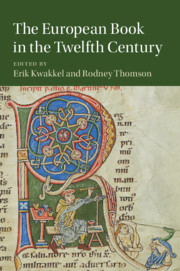Book contents
- The European Book in the Twelfth Century
- Cambridge Studies in Medieval Literature
- The European Book in the Twelfth Century
- Copyright page
- Dedication
- Contents
- Figures
- Contributors
- Preface
- Abbreviations
- Introduction
- Part I Book Production
- Part II Readers and Their Books
- Part III Types of Books
- Chapter 9 Hebrew Books
- Chapter 10 Liturgical Books
- Chapter 11 Books of Theology and Bible Study
- Chapter 12 Logic
- Chapter 13 The Classical Revival
- Chapter 14 Reading the Sciences
- Chapter 15 Medical Books
- Chapter 16 Law Books
- Chapter 17 Vernacular Manuscripts I: Britain and France
- Chapter 18 Vernacular Manuscripts II: Germany
- Bibliography
- Index of Manuscripts
- General Index
- Cambridge Studies in Medieval Literature
Chapter 9 - Hebrew Books
from Part III - Types of Books
Published online by Cambridge University Press: 03 July 2018
- The European Book in the Twelfth Century
- Cambridge Studies in Medieval Literature
- The European Book in the Twelfth Century
- Copyright page
- Dedication
- Contents
- Figures
- Contributors
- Preface
- Abbreviations
- Introduction
- Part I Book Production
- Part II Readers and Their Books
- Part III Types of Books
- Chapter 9 Hebrew Books
- Chapter 10 Liturgical Books
- Chapter 11 Books of Theology and Bible Study
- Chapter 12 Logic
- Chapter 13 The Classical Revival
- Chapter 14 Reading the Sciences
- Chapter 15 Medical Books
- Chapter 16 Law Books
- Chapter 17 Vernacular Manuscripts I: Britain and France
- Chapter 18 Vernacular Manuscripts II: Germany
- Bibliography
- Index of Manuscripts
- General Index
- Cambridge Studies in Medieval Literature
Summary
- Type
- Chapter
- Information
- The European Book in the Twelfth Century , pp. 159 - 174Publisher: Cambridge University PressPrint publication year: 2018

